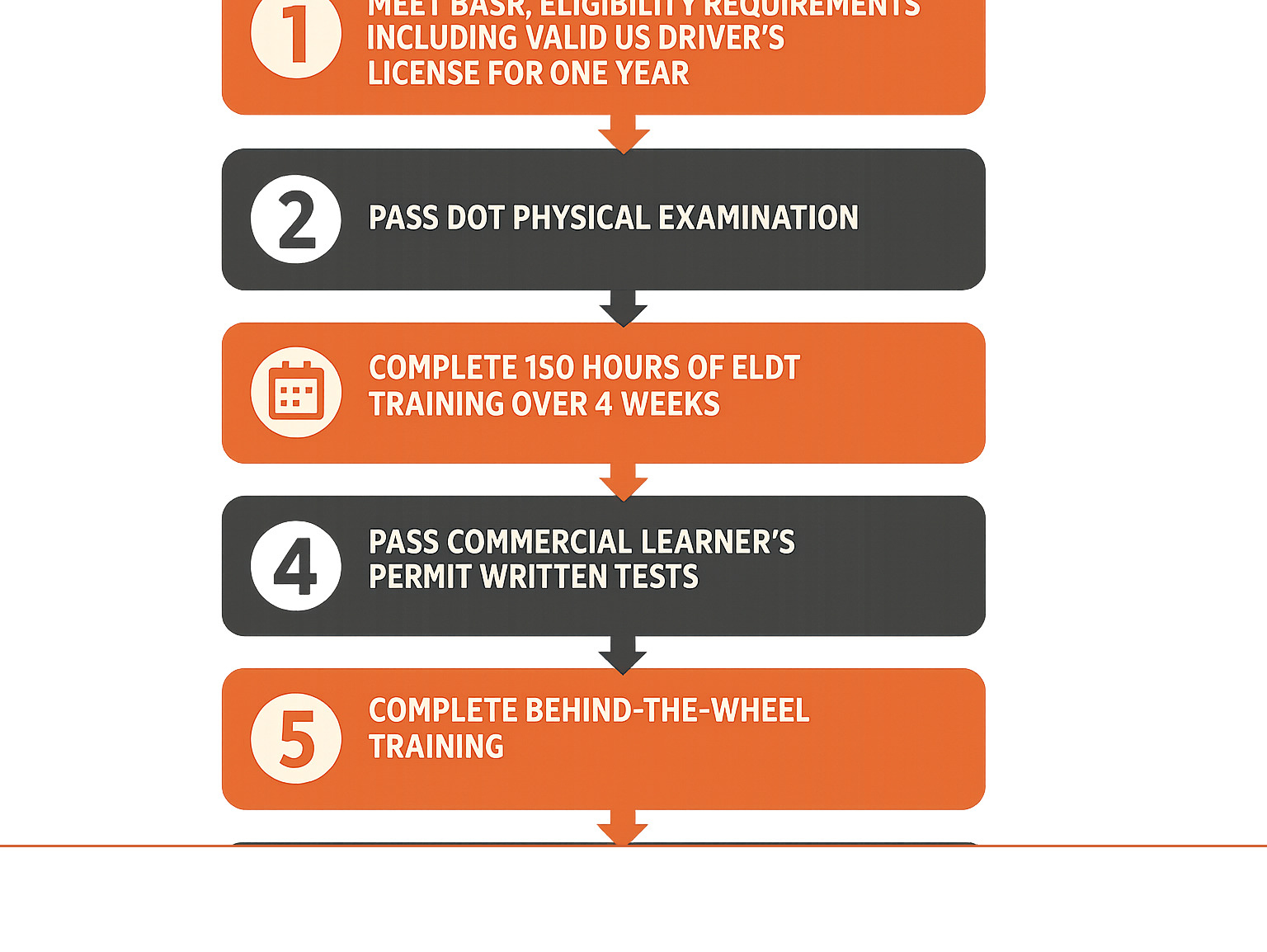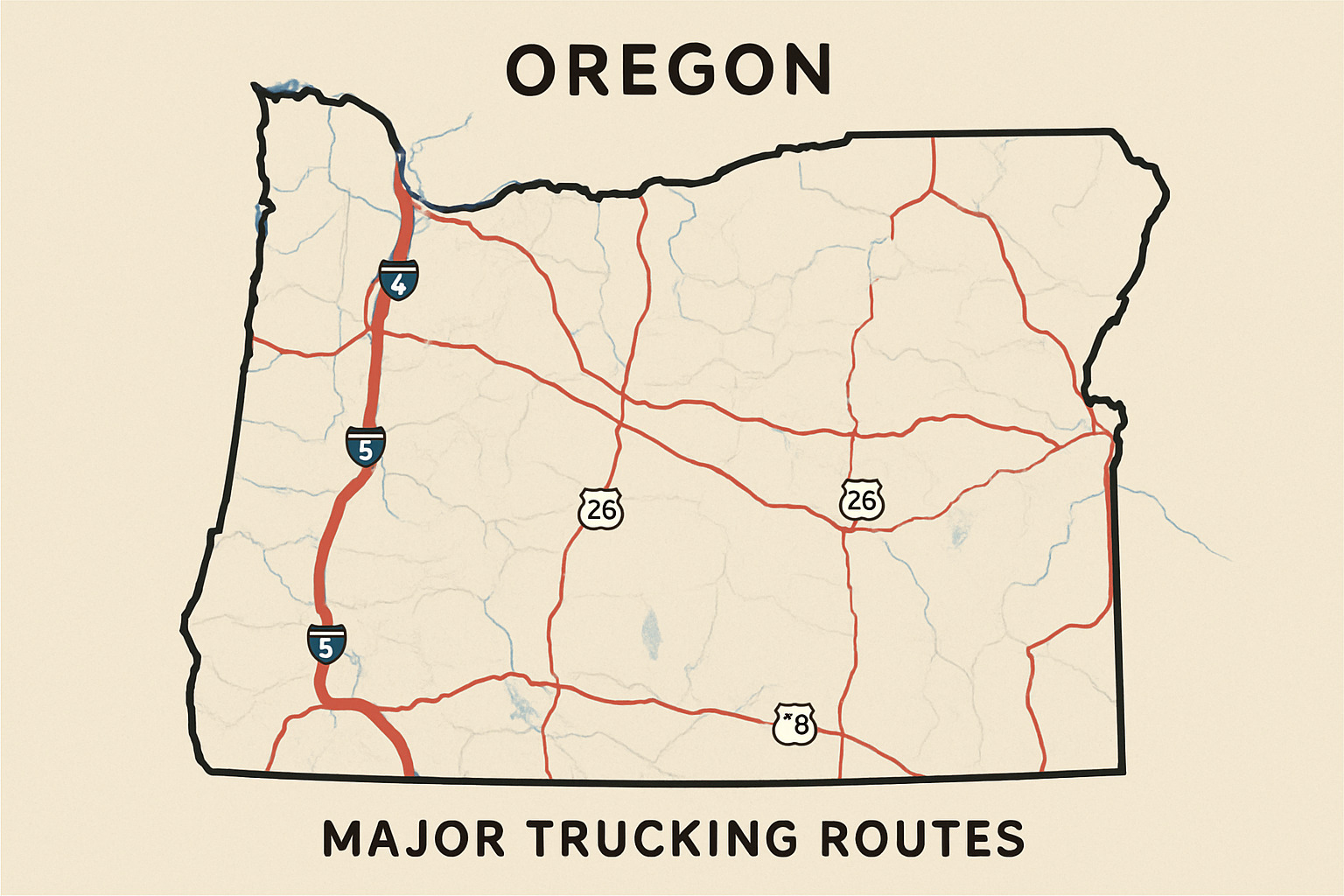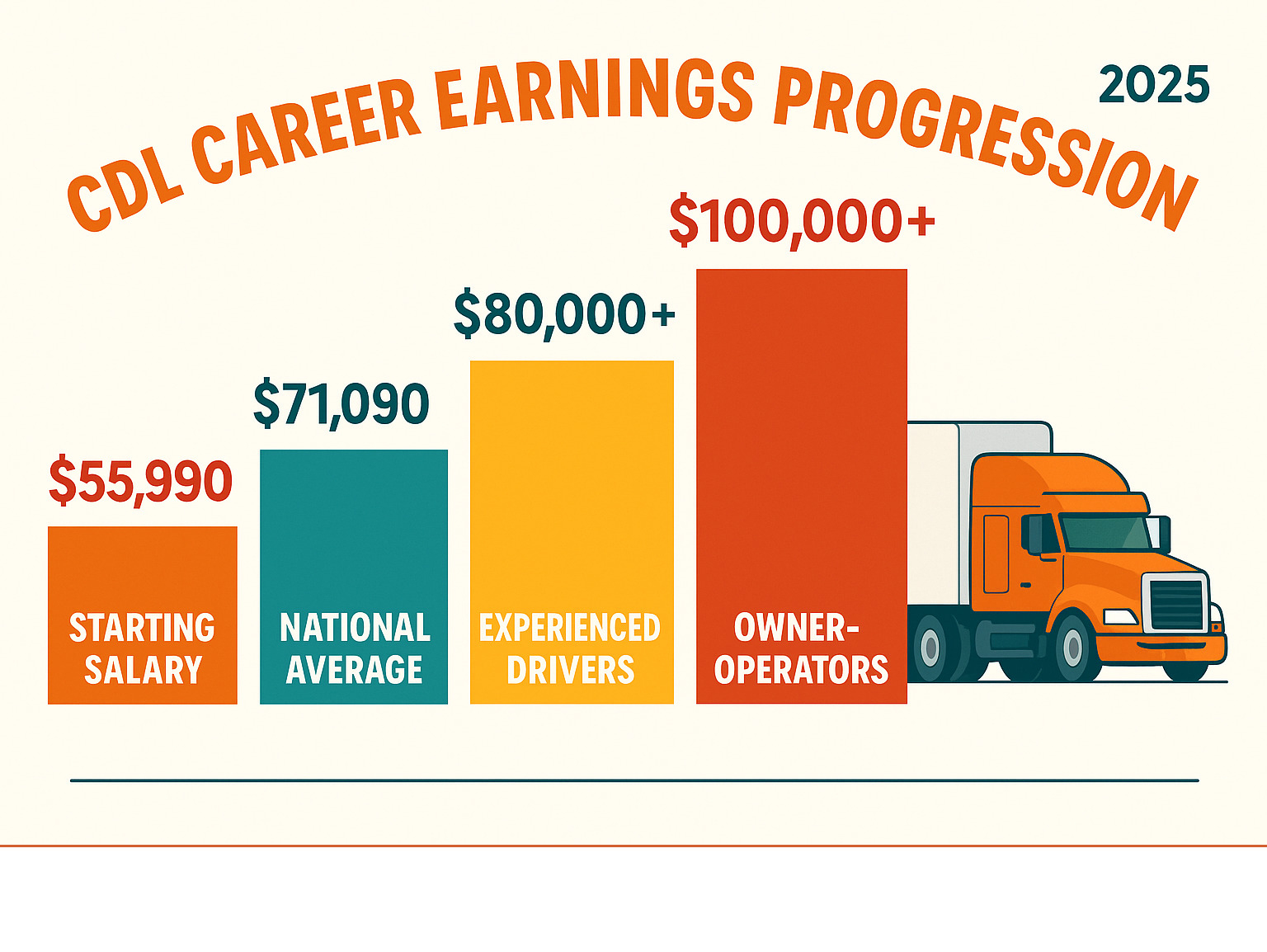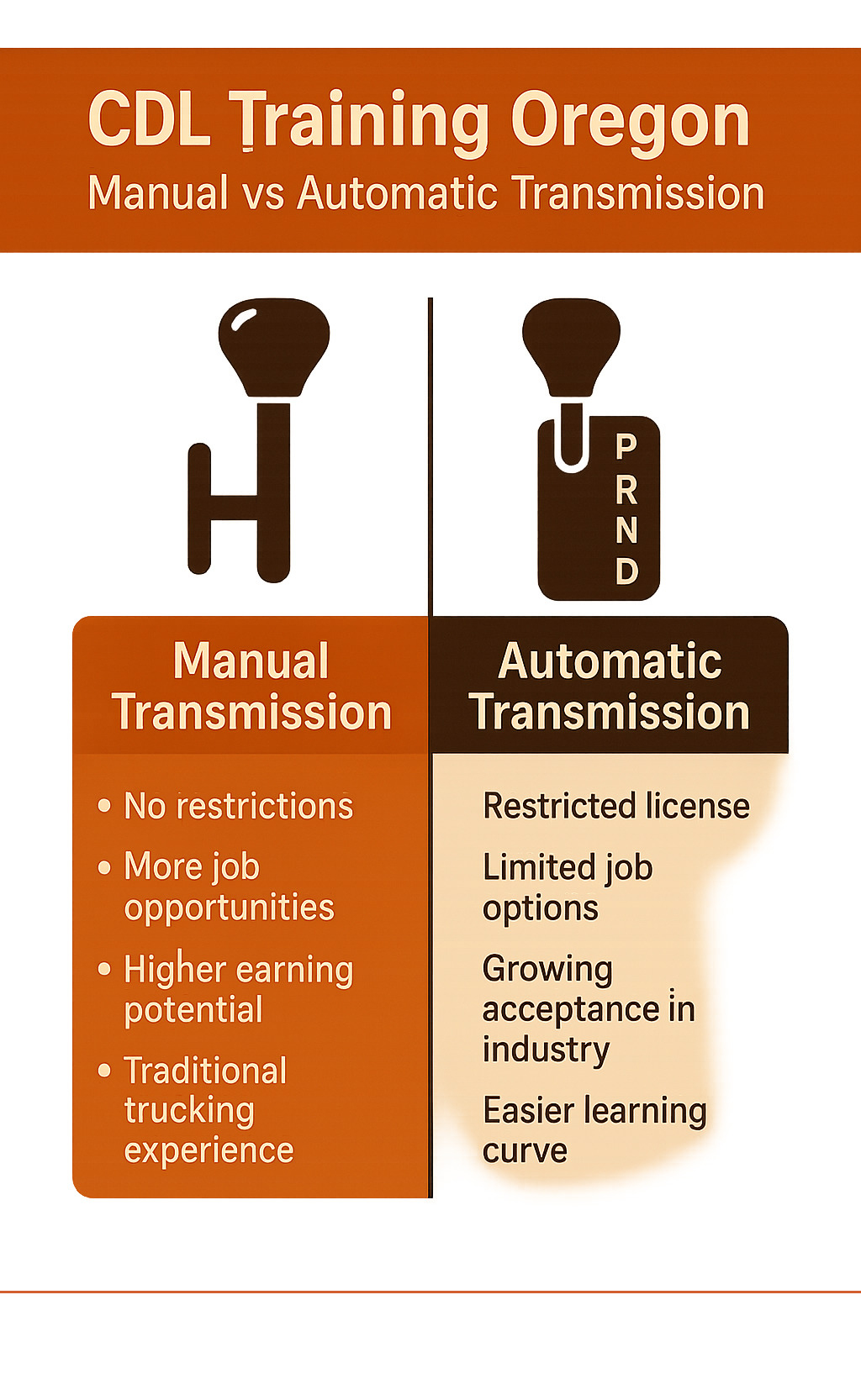CDL Training Oregon: Achieve Success 2025
Your Roadmap to a Professional Driving Career in Oregon
CDL training Oregon is your gateway to a stable, well-paying career in one of America’s most essential industries. With a projected nationwide shortage of 174,000 drivers by 2026, qualified commercial drivers can count on strong job security and competitive wages.
Elite Truck School has helped launch thousands of careers over the past two decades, providing comprehensive Class A CDL instruction at convenient campuses in Portland, Hillsboro, Albany and Vancouver. Our 160-hour, four-week program prepares you to meet every federal Entry-Level Driver Training (ELDT) requirement and pass the Oregon CDL skills test on your first attempt.
Key Requirements for Oregon CDL Training
- Hold a valid U.S. driver’s license for at least one year
- Be 18 + for intrastate or 21 + for interstate driving
- Pass a DOT physical examination
- Demonstrate English proficiency (all training and testing are English-only)
- Complete 160 hours of ELDT-compliant training
The trucking industry offers remarkable career stability. Graduates of quality programs report average first-year earnings around $55,990, with national averages climbing above $71,000 and experienced drivers often earning six figures.
Why pursue a Class A CDL? It qualifies you to operate combination vehicles, straight trucks and most Class B equipment, opening doors to local delivery, regional freight and long-haul positions throughout Oregon, Washington and beyond.
All Oregon CDL training follows federal ELDT regulations. Instruction blends classroom study of DOT regulations with hands-on yard practice and extensive behind-the-wheel driving—all in English to meet Department of Transportation communication standards.

Understanding Oregon’s CDL Requirements and the ELDT Mandate

Getting your CDL training Oregon starts with understanding the regulatory framework that governs commercial driving. Oregon’s commercial driver licensing system operates under both federal and state regulations, creating a comprehensive framework designed to ensure public safety while meeting the transportation industry’s workforce needs. The Federal Motor Carrier Safety Administration (FMCSA) establishes nationwide standards, while Oregon’s Department of Motor Vehicles implements state-specific procedures.
The Entry-Level Driver Training (ELDT) mandate, which took effect February 7, 2022, fundamentally changed how new commercial drivers receive their training. This federal requirement ensures all first-time CDL applicants, those upgrading their license class, and drivers seeking certain endorsements receive standardized, quality instruction from FMCSA-registered providers. Understanding these requirements helps you choose the right training path and avoid costly delays in your career launch. Top Reasons to Enroll in a CDL Training Program provides additional insight into the benefits of formal training programs.
Basic Eligibility for CDL Training in Oregon
Oregon’s CDL eligibility requirements establish minimum standards for commercial driver candidates. The age requirements vary based on your intended driving scope: you must be at least 18 years old for intrastate commercial driving within Oregon’s borders, while interstate operations require a minimum age of 21. This distinction affects your initial career options, as many entry-level positions involve crossing state lines.
You’ll need a valid US driver’s license that you’ve held for at least one year. This doesn’t need to be an Oregon license—any valid US license meets the requirement. The Oregon DMV doesn’t conduct extensive eligibility checks beyond court orders suspending driving privileges entirely or DUI convictions in commercial vehicles.
The DOT physical examination represents a critical component of CDL eligibility. This comprehensive medical assessment evaluates your physical and mental fitness to operate commercial vehicles safely. The examination covers cardiovascular health, vision standards (20/40 or better with or without corrective lenses), hearing standards (ability to perceive forced whisper at five feet), neurological function, and substance abuse screening. Find a certified medical examiner through the National Registry to ensure your examination meets federal standards.
Your clean driving record undergoes review during the application process. While minor violations may not disqualify you from training, major offenses such as DUI convictions, reckless driving, or excessive speeding violations can impact your eligibility. The Oregon DMV evaluates each case individually, considering the nature and timing of violations. Admissions Information provides detailed guidance on how driving history affects your training eligibility.
The Role of Entry-Level Driver Training (ELDT)
Entry-Level Driver Training represents the most significant change in commercial driver education in decades. This federal mandate ensures consistent, quality training across all providers. The FMCSA Training Provider Registry maintains a comprehensive database of approved training providers, tracking your training completion and automatically notifying testing authorities when you’ve fulfilled the requirements.
Who needs ELDT includes first-time Class A or Class B CDL applicants, drivers upgrading from Class B to Class A, and drivers seeking initial passenger (P), school bus (S), or hazardous materials (H) endorsements. If you’re pursuing your first CDL, you’ll need to complete this training before scheduling your skills test.
The ELDT curriculum combines theory instruction with behind-the-wheel training. Theory instruction covers federal regulations, vehicle systems, safety protocols, and professional responsibilities. Behind-the-wheel training develops the physical skills necessary for safe vehicle operation. Per ELDT regulations, training requires 160 hours and is typically completed over a 4-week period. Search for an ELDT provider to locate approved training programs in your area.
ELDT training must be completed before you can schedule your CDL skills test. The Training Provider Registry automatically records your completion, eliminating the need for paper certificates. This digital system streamlines the licensing process while maintaining accurate training records. ELDT Training Requirements explains the specific components and expectations of compliant training programs.
Decoding CDL Classes and Endorsements
Oregon issues three primary classes of commercial driver licenses, each corresponding to specific vehicle types and weight categories. Understanding these classifications helps you choose the appropriate training program and career path.
Class A CDL authorizes operation of combination vehicles with a gross combination weight rating (GCWR) of 26,001 pounds or more, provided the towed vehicle exceeds 10,000 pounds. This license class offers the greatest career flexibility, qualifying you for local delivery, regional freight, and long-haul transportation positions. Importantly, with a Class A license, you’re qualified to drive Class B vehicles as well, maximizing employment opportunities across the transportation sector.
Class B CDL covers straight trucks with a gross vehicle weight rating (GVWR) of 26,001 pounds or more, including dump trucks and buses. While more limited than Class A, Class B licenses provide excellent local and regional employment opportunities in construction, waste management, and passenger transportation.
Common endorsements expand your driving privileges and career options. The HazMat (H) endorsement authorizes transportation of hazardous materials requiring placards. The Tanker (N) endorsement permits operation of tank vehicles. The Doubles/Triples (T) endorsement allows pulling multiple trailers. These endorsements can significantly increase your earning potential and job opportunities.
Class A CDL Training provides comprehensive preparation for the most versatile commercial license class, opening doors to diverse career opportunities throughout the transportation industry.
What to Expect from a Comprehensive CDL Training Program

A comprehensive CDL training Oregon program transforms complete beginners into confident, skilled commercial drivers through structured, professional instruction. Quality training programs combine rigorous classroom education with extensive hands-on practice, ensuring you develop both the knowledge and practical skills necessary for safe vehicle operation and professional success.
Professional instruction serves as the cornerstone of effective training programs. Experienced instructors bring decades of real-world commercial driving experience into the classroom and training yard, sharing practical insights that textbooks simply cannot provide. These seasoned professionals understand the challenges new drivers face and guide you through each step of the learning process with patience and expertise.
The learning environment emphasizes safety, professionalism, and career preparation. You’ll find that successful commercial driving requires much more than simply operating a large vehicle—it demands understanding complex regulations, maintaining detailed records, and developing the judgment necessary for split-second decisions on the road. What to Expect From a Truck Driving School provides detailed insights into the comprehensive training experience and professional expectations.
The Core Components of Your Training
Classroom instruction establishes the essential theoretical foundation for your commercial driving career. This comprehensive curriculum covers DOT regulations, hours of service requirements, trip planning, vehicle systems, and critical safety protocols. Students learn to interpret complex federal regulations, understand their professional responsibilities, and develop the knowledge base necessary for success on the CDLP written tests.
The classroom component includes thorough CDLP test preparation, where instructors review test content, explain complex concepts, and provide practice opportunities to ensure your success. This preparation proves crucial since you must obtain your Commercial Learner’s Permit before beginning behind-the-wheel training. The instruction covers general knowledge, combination vehicles, and air brakes systems—all essential components of professional commercial driving.
Yard training develops fundamental vehicle operation skills in a controlled, safe environment. Students master essential maneuvers including backing skills, coupling and uncoupling procedures, and comprehensive vehicle inspections. The training yard provides the perfect space to practice challenging maneuvers without the pressures and dangers of public roads.
During yard training, you’ll repeat maneuvers until achieving proficiency, building the muscle memory and confidence essential for professional success. Instructors provide individualized feedback, helping you refine techniques and overcome specific challenges. This patient, methodical approach ensures every student develops solid foundational skills before progressing to road driving.
Behind-the-wheel driving represents the culmination of your training experience, where classroom knowledge and yard skills merge in real-world driving situations. Students learn shifting techniques for manual transmissions, defensive driving strategies, and professional driving practices. This instruction covers urban and highway driving skills, commercial backing and parking, and the professional judgment necessary for safe vehicle operation.
CDL Training Curriculum outlines the specific components and progression of professional training programs, ensuring you understand exactly what to expect throughout your educational journey.
Program Duration and Structure
Federal ELDT regulations mandate 160 hours of training, typically completed over a structured four-week timeline. This intensive schedule requires full-time commitment, with students attending classes Monday through Friday for approximately eight hours daily. The structured timeline ensures comprehensive coverage of all required topics while maintaining reasonable progression through increasingly complex skills.
English proficiency requirements are absolutely essential in commercial driver training. Per D.O.T. communication standards, CDL holders must read, write, and verbally communicate effectively in English. All training instruction is conducted exclusively in English, and Oregon administers the CDL skills test only in English. This requirement ensures drivers can understand written regulations, communicate effectively with law enforcement and emergency personnel, read shipping documents and road signs, and complete required paperwork accurately.
The four-week intensive format accelerates your entry into the workforce while ensuring thorough preparation for professional responsibilities. Students progress systematically from basic concepts to advanced applications, building competency through repetition and practice. This concentrated approach maintains student engagement while providing the comprehensive education necessary for career success.
CDL Training Programs provides detailed information about program structure, scheduling options, and expectations for student participation and commitment throughout your professional training experience.
Navigating the Oregon CDL Testing and Licensing Process
Oregon’s CDL testing and licensing process follows a structured path designed to verify your knowledge and skills meet federal safety standards. The Oregon DMV oversees this process while working with third-party testing providers to ensure consistent, fair evaluation of all candidates.
Understanding each step helps you prepare effectively and avoid common delays that can postpone your licensing. The process includes written knowledge tests for your Commercial Learner’s Permit (CDLP) and comprehensive skills testing for your full CDL. Understanding the CDL Licensing Process provides additional insight into the steps and requirements involved.
Passing the Commercial Learner’s Permit (CLP) Knowledge Tests
The CDLP knowledge tests evaluate your understanding of commercial driving regulations, vehicle systems, and safety protocols. These written examinations must be passed before you can begin behind-the-wheel training, making thorough preparation essential for program success.
Required knowledge tests include the General Knowledge test, which covers basic commercial driving concepts, regulations, and safety procedures. Class A CDL applicants must also pass the Combination Vehicles test, focusing on combination vehicle operation. The Air Brakes test is mandatory for vehicles equipped with air brake systems, while endorsement knowledge tests cover specialized operations like HazMat or passenger transport.
Each test requires a passing score of 80% or higher. The examinations use multiple-choice questions drawn from the Oregon Commercial Driver Manual. Test questions cover practical scenarios you’ll encounter as a professional driver, emphasizing real-world application of regulatory knowledge rather than simple memorization.
The DMV application process has been streamlined through online services. You can start your application online to begin the licensing process and schedule your knowledge tests. Online applications reduce waiting times and allow you to complete preliminary paperwork before visiting the DMV office.
Mastering the CDL Skills Test in Oregon
The CDL skills test represents the final step in obtaining your commercial driver license. This comprehensive examination evaluates your ability to safely operate commercial vehicles through three distinct components, each designed to assess different aspects of professional driving competency.
Pre-Trip Vehicle Inspection tests your ability to identify potential safety hazards and mechanical problems. You must demonstrate systematic inspection procedures, correctly identify vehicle components, and explain what you’re looking for during each inspection step. This segment emphasizes safety consciousness and attention to detail—critical qualities for professional drivers.
Basic Control Skills evaluation occurs in a controlled environment, typically at the testing facility. You’ll demonstrate your ability to perform precise maneuvers including straight-line backing, alley docking, and parallel parking. These skills are essential for professional operations, as commercial drivers frequently steer tight spaces and challenging backing situations.
On-Road Driving Test assesses your ability to safely operate commercial vehicles in traffic. The examiner evaluates your following distance, speed control, lane positioning, turning techniques, and overall traffic awareness. This segment demonstrates your readiness to operate commercial vehicles safely in real-world conditions.
Oregon administers the CDL skills test exclusively in English, reflecting federal requirements for commercial driver communication abilities. You must schedule your skills test with an approved third-party tester, and you’re responsible for providing an appropriate vehicle for testing. Using the right vehicle class for your intended license is crucial—you cannot test for a Class A CDL using a Class B vehicle.
More on Oregon’s CDL requirements provides detailed information about testing procedures and requirements to help you prepare for success.
The Investment and Career Outlook for CDL Training Oregon

Investing in CDL training Oregon programs is one of the fastest, most affordable ways to enter a high-demand field. Unlike multi-year college degrees, a four-week ELDT-approved course at Elite Truck School delivers immediate access to well-paid driving jobs.
Industry fundamentals remain strong: freight must keep moving in every economy, and current projections show the driver shortage widening for years to come. This persistent demand supports wage growth and outstanding job security for new and experienced drivers alike.
Understanding Costs and Financial Assistance
Program tuition at Elite Truck School is a fraction of traditional higher-education expenses. Additional costs—DMV fees, DOT physical, CLP and skills testing—are modest and clearly outlined during enrollment.
Multiple funding sources can offset or even cover your tuition:
- GI Bill® benefits for qualifying veterans
- Oregon Future Ready Grant and other state workforce programs
- Employer tuition reimbursement once you enter the industry
Tuition Assistance for CDL Training explains how to apply for these options, while CDL Training for Military Veterans details veteran benefits.
Your Career Path After Graduation
Class A CDL holders enjoy best flexibility. Many graduates start in local positions that get them home nightly, others choose regional routes with two to three nights on the road, and some pursue OTR opportunities for maximum income and travel.
Elite Truck School’s dedicated placement team maintains relationships with carriers across Oregon, Washington and the wider Pacific Northwest, helping graduates secure interviews quickly. Reported starting salaries average $55,990, with national averages around $71,090 and seasoned drivers routinely topping $80,000+. Owner-operators and specialized drivers can earn six-figure incomes.

Most students recover their training costs within months of graduation, making CDL school one of the best returns on educational investment available today.
CDL Job Placement Assistance outlines the lifetime support you’ll receive from our staff as you advance through a rewarding trucking career.
Frequently Asked Questions about Oregon CDL Training
How long does it take to get a CDL in Oregon?
The complete CDL training Oregon process typically takes 4-6 weeks from start to finish, depending on your preparation and testing schedule. The journey begins with your 160-hour ELDT training program, which is completed over a four-week period with full-time commitment Monday through Friday.
During this intensive training, you’ll attend classes for approximately eight hours daily, covering everything from classroom instruction to hands-on driving practice. This concentrated format helps you build skills quickly while ensuring you receive comprehensive preparation for your professional driving career.
After completing your training program, you must hold your Commercial Learner’s Permit for at least 14 days before you can schedule your CDL skills test. This waiting period allows you to practice and reinforce the skills you’ve learned during training.
Skills test scheduling and DMV processing add additional time to your overall timeline. Third-party testing providers may have varying availability, so it’s wise to schedule your test as early as possible after completing your training. Once you pass your skills test, the Oregon DMV typically processes your CDL within a few business days.
Can I get a CDL if I have points on my license?
Having points on your driver’s license doesn’t automatically disqualify you from CDL training Oregon programs or licensing, as long as your license remains valid and in good standing. The Oregon DMV evaluates each situation individually, focusing on the nature and timing of violations rather than applying blanket restrictions.
However, your driving record plays a significant role in your employment prospects after graduation. While you might qualify for training and testing, employers and insurance companies maintain strict standards for commercial drivers. They often require clean driving records for employment, making your driving history a crucial factor in job placement success.
Major violations such as DUI convictions, reckless driving, or excessive speeding can severely limit your job opportunities, even if you successfully obtain your CDL. These violations raise red flags for employers who prioritize safety and liability management.
Minor violations typically have less impact on employability, especially if they occurred several years ago. Many employers consider the overall pattern of your driving behavior rather than isolated incidents, giving you the opportunity to demonstrate improved driving habits over time.
Do I need to train on a manual transmission?
Oregon allows CDL testing on both manual and automatic transmissions, but your choice significantly affects your career opportunities. If you test on an automatic transmission vehicle, your CDL will include an automatic-only restriction, which limits the types of vehicles you can legally operate as a commercial driver.
Manual transmission training provides much greater career flexibility in the trucking industry. Many commercial vehicles still use manual transmissions, particularly in long-haul and specialized freight operations. Employers often prefer drivers who can operate both transmission types, which expands your job opportunities and potentially increases your earning potential.
The trucking industry is gradually shifting toward automatic transmissions, especially in fleet operations focused on driver comfort and fuel efficiency. However, manual transmission skills remain valuable for several reasons: they demonstrate mechanical aptitude, provide better vehicle control in challenging conditions, and qualify you for a broader range of equipment.
Quality training programs offer instruction on both transmission types, allowing you to make an informed choice based on your career goals. If you’re planning to pursue local delivery routes with modern fleets, automatic transmission training might suffice. However, if you’re interested in diverse opportunities across the industry, manual transmission training offers the most flexibility for your professional future.

Conclusion: Start Your Engine with the Right Training Partner
Your journey toward a rewarding career in commercial transportation begins with a single decision: choosing the right training partner. The trucking industry stands at a crossroads of opportunity, with the nationwide driver shortage creating unprecedented demand for skilled, professional drivers. This isn’t just about finding a job—it’s about building a stable, well-paying career in one of America’s most essential industries.
CDL training Oregon programs offer your gateway to this opportunity, but the quality of your training determines your success. Professional instruction does more than prepare you for testing; it builds the foundation for a lifetime of safe, profitable driving. The difference between basic training and comprehensive preparation often determines whether you simply pass your tests or excel in your new career.
Elite Truck School has spent over two decades perfecting our approach to commercial driver education. Our comprehensive training programs combine experienced instruction with hands-on practice, ensuring you develop both the technical skills and professional confidence necessary for success. We understand that every student brings unique goals and challenges, which is why we provide personalized attention throughout your training journey.
Our commitment extends far beyond graduation day. We maintain high job placement rates by building strong relationships with regional employers who trust our graduates. Whether you’re interested in local driving positions that get you home every night, regional routes that balance travel with family time, or over-the-road opportunities that offer the highest earning potential, our network of employer partners provides diverse career options.
The versatility of Class A CDL training opens doors across the transportation industry. Our graduates find rewarding careers in local delivery, regional freight, and long-haul transportation. Your Class A license also qualifies you to operate Class B vehicles, expanding your employment opportunities significantly. This flexibility ensures you can adapt your career as your life circumstances change.

What sets Elite Truck School apart is our lifetime support for graduates. Your relationship with us doesn’t end when you receive your CDL. We provide ongoing career guidance, refresher training opportunities, and continued job placement assistance throughout your driving career. This comprehensive support system reflects our commitment to your long-term success.
Our locations throughout Oregon and Southwest Washington provide convenient access to quality training in Portland, Hillsboro, Albany, and Vancouver. We understand the local market conditions and maintain strong connections with employers throughout the region. This local knowledge helps us prepare you for the specific challenges and opportunities you’ll encounter in your professional driving career.
The time to begin your commercial driving career is now. With industry demand at historic levels and quality training programs available throughout Oregon, you have the opportunity to build a stable, rewarding career that offers both financial security and professional satisfaction. The trucking industry needs skilled, safety-conscious drivers who take pride in their work—drivers exactly like the ones we train at Elite Truck School.
Explore our CDL Training Programs to learn more about how Elite Truck School can help you achieve your professional driving goals. Contact us today to begin your journey toward a successful career in commercial transportation. Your new career is waiting—let us help you get there.
